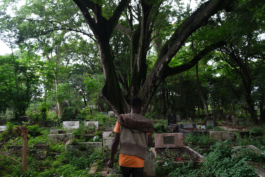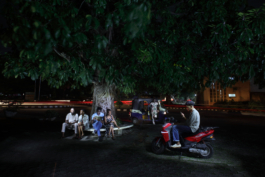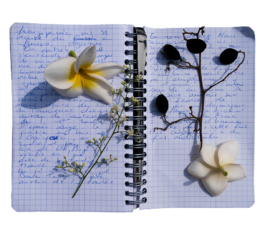Since 2017, the anthropologist Emilie Guitard and the visual artists the Chevalme Sisters, joined then from 2022 by the photographer Ọbáyọmí A. Anthony (within the framework of the international research program INFRAPATRI), have started together fieldwork in Ìbàdàn, in south-west Nigeria, on local knowledge and relations of the inhabitants to the vegetation present in the city. Founded in the first half of the 19th century, Ìbàdàn now has a population of around 4 million living in an area of about 700km², mostly Yorùbá. Despite this high population, the city is still home to a large number of urban trees of different species and to several large wooded areas of various types (wooded hills, botanical gardens, private parks, cemeteries, etc).
Combining drawings, photographs and extracts from ethnographic notebooks, this project documents the rich relations that Ìbàdàn’s inhabitants have with plants surrounding them.
More than just elements of the urban landscape or objects of amenity, trees and wooded areas are supports for urban memories and the history of Ìbàdàn, land markers, stocks of medicinal resources, nodes in the network of ritual spaces weaving the city, and places of work, trade, leisure and daily sociability. However, Ìbàdàn’s vegetation is also under threat: from urban expansion and densification, but also from land pressure and speculation, combined with a certain conception of urban modernity, which gives priority to buildings and concrete over plants, or from competition between religions, where trees in particular become stakes and targets.
This collaboration reveals the complexity of relationships with plants in a major city in sub-Saharan Africa. Contrary to an over-simplistic vision of the place to be given to nature in the city, mediated by the trendy concept of the «sustainable city», the daily cohabitation of city dwellers and plants in Ìbàdàn allows us to consider other ways of living with nature in the city.

Terminalia catappa in front of the compound of the lineage Delesolu. Drawings by Delphine and Elodie Chevalme, Ojé, October 2017.
"As Yorùbá, people have to ask our permission before taking leaves for medicinal preparations àgbo, it is a matter of respect. Nobody comes at night, because then the leaves are asleep, so you can't pick them, they won't work. They wake up and work again from 6 or 7 in the morning. Roots and bark are also used for medicinal purposes, but it is the same thing: they sleep at night, because in fact the whole tree is asleep, resting, just like human beings. However, if you need to pick leaves at night, some people know incantations, ògèdè, to wake them up" (Mrs Amuda A., 75 years old, Yorùbá Ìbàdàn, Ìyàna Lábíran, February 2016)

Sango cemerety. Drawings by Delphine and Elodie Chevalme, July 2023.
A young gravedigger showing us his favourite trees in Sango cemetery. Picture Obáyomí A. Anthony, July 2023.

"I like this job, it's a quiet place, it's beautiful and peaceful, there are big trees, flowers growing on the ground, even fruits like mangoes, pineapples, pawpaws, once bananas, that have spontaneously sprouted there. You are free to move around here; if you are bored, you can go for a walk in any part of the cemetery. People are afraid of us, they think we do juju or that we have charms, óògùn, to work here, in any case that we are very powerful, but there is nothing like that. Sometimes we feel the spirits when we dig the graves, a breeze as if someone brushed past you. But we don't have any problems with the spirits, their souls are pure and they are not evil" (Dàmọ́lá, 32 years old, Yorùbá Ìbàdàn, gravedigger at Sango cemetery, July 2023)

Students chilling out under a strangler fig at the University of Ìbàdàn. Picture Delphine and Elodie Chevalme, July 2023.
"In the hollowed ground where knowledge on Mother Africa is sought and unearthed;
Your roots spread in endless quest for nourishment as you aged with grace;
While your branches grant succour to generations of tensed, at times frustrated souls;
As they wait endlessly to learn of their fate;
As mixture of cries of anguish and sighs of relief;
Tears which symbolised the joy of liberation from the jaws of the Monster of Abstract;
Or yet another painful wait for months to return to thy bosom;
Fate drove each on to where destiny lies;" (Dr. Philip A. Olayoku, Facebook, October 2016)

Emilie's field notebook decorated with plant elements on the bonnet of the car belonging to Fred Akínyẹmí, driver and member of the project. Picture Obáyomí A. Anthony, Òkè Aré, December 2022.
See more about the program INFRAPATRI here.
Since 2017, the anthropologist Emilie Guitard and the visual artists the Chevalme Sisters, joined then from 2022 by the photographer Ọbáyọmí A. Anthony (within the framework of the international research program INFRAPATRI), have started together fieldwork in Ìbàdàn, in south-west Nigeria, on local knowledge and relations of the inhabitants to the vegetation present in the city. Founded in the first half of the 19th century, Ìbàdàn now has a population of around 4 million living in an area of about 700km², mostly Yorùbá. Despite this high population, the city is still home to a large number of urban trees of different species and to several large wooded areas of various types (wooded hills, botanical gardens, private parks, cemeteries, etc).
Combining drawings, photographs and extracts from ethnographic notebooks, this project documents the rich relations that Ìbàdàn’s inhabitants have with plants surrounding them.
More than just elements of the urban landscape or objects of amenity, trees and wooded areas are supports for urban memories and the history of Ìbàdàn, land markers, stocks of medicinal resources, nodes in the network of ritual spaces weaving the city, and places of work, trade, leisure and daily sociability. However, Ìbàdàn’s vegetation is also under threat: from urban expansion and densification, but also from land pressure and speculation, combined with a certain conception of urban modernity, which gives priority to buildings and concrete over plants, or from competition between religions, where trees in particular become stakes and targets.
This collaboration reveals the complexity of relationships with plants in a major city in sub-Saharan Africa. Contrary to an over-simplistic vision of the place to be given to nature in the city, mediated by the trendy concept of the «sustainable city», the daily cohabitation of city dwellers and plants in Ìbàdàn allows us to consider other ways of living with nature in the city.

Terminalia catappa in front of the compound of the lineage Delesolu. Drawings by Delphine and Elodie Chevalme, Ojé, October 2017.
"As Yorùbá, people have to ask our permission before taking leaves for medicinal preparations àgbo, it is a matter of respect. Nobody comes at night, because then the leaves are asleep, so you can't pick them, they won't work. They wake up and work again from 6 or 7 in the morning. Roots and bark are also used for medicinal purposes, but it is the same thing: they sleep at night, because in fact the whole tree is asleep, resting, just like human beings. However, if you need to pick leaves at night, some people know incantations, ògèdè, to wake them up" (Mrs Amuda A., 75 years old, Yorùbá Ìbàdàn, Ìyàna Lábíran, February 2016)

Sango cemerety. Drawings by Delphine and Elodie Chevalme, July 2023.

A young gravedigger showing us his favourite trees in Sango cemetery. Picture Obáyomí A. Anthony, July 2023.
"I like this job, it's a quiet place, it's beautiful and peaceful, there are big trees, flowers growing on the ground, even fruits like mangoes, pineapples, pawpaws, once bananas, that have spontaneously sprouted there. You are free to move around here; if you are bored, you can go for a walk in any part of the cemetery. People are afraid of us, they think we do juju or that we have charms, óògùn, to work here, in any case that we are very powerful, but there is nothing like that. Sometimes we feel the spirits when we dig the graves, a breeze as if someone brushed past you. But we don't have any problems with the spirits, their souls are pure and they are not evil" (Dàmọ́lá, 32 years old, Yorùbá Ìbàdàn, gravedigger at Sango cemetery, July 2023)

Students chilling out under a strangler fig at the University of Ìbàdàn. Picture Delphine and Elodie Chevalme, July 2023.
"In the hollowed ground where knowledge on Mother Africa is sought and unearthed;
Your roots spread in endless quest for nourishment as you aged with grace;
While your branches grant succour to generations of tensed, at times frustrated souls;
As they wait endlessly to learn of their fate;
As mixture of cries of anguish and sighs of relief;
Tears which symbolised the joy of liberation from the jaws of the Monster of Abstract;
Or yet another painful wait for months to return to thy bosom;
Fate drove each on to where destiny lies;" (Dr. Philip A. Olayoku, Facebook, October 2016)

Emilie's field notebook decorated with plant elements on the bonnet of the car belonging to Fred Akínyẹmí, driver and member of the project. Picture Obáyomí A. Anthony, Òkè Aré, December 2022.
See more about the program INFRAPATRI here.